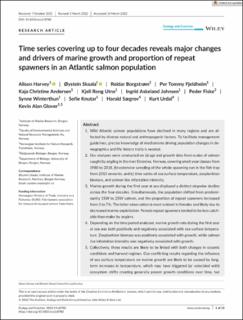| dc.contributor.author | Harvey, Alison C. | |
| dc.contributor.author | Skaala, Øystein | |
| dc.contributor.author | Borgstrøm, Reidar | |
| dc.contributor.author | Andersen-Fjeldheim, Per Tommy | |
| dc.contributor.author | Andersen-Fjeldheim, Kaja Christine | |
| dc.contributor.author | Utne, Kjell Rong | |
| dc.contributor.author | Johnsen, Ingrid Askeland | |
| dc.contributor.author | Fiske, Peder | |
| dc.contributor.author | Winterthun, Synnøve | |
| dc.contributor.author | Knutar, Sofie | |
| dc.contributor.author | Sægrov, Harald | |
| dc.contributor.author | Urdal, Kurt | |
| dc.contributor.author | Glover, Kevin Alan | |
| dc.date.accessioned | 2022-08-12T11:12:51Z | |
| dc.date.available | 2022-08-12T11:12:51Z | |
| dc.date.created | 2022-05-12T14:30:04Z | |
| dc.date.issued | 2022 | |
| dc.identifier.citation | Ecology and Evolution. 2022, 12 (4), . | en_US |
| dc.identifier.issn | 2045-7758 | |
| dc.identifier.uri | https://hdl.handle.net/11250/3011605 | |
| dc.description.abstract | Wild Atlantic salmon populations have declined in many regions and are affected by diverse natural and anthropogenic factors. To facilitate management guidelines, precise knowledge of mechanisms driving population changes in demographics and life history traits is needed. | en_US |
| dc.language.iso | eng | en_US |
| dc.title | Time series covering up to four decades reveals major changes and drivers of marine growth and proportion of repeat spawners in an Atlantic salmon population | en_US |
| dc.title.alternative | Time series covering up to four decades reveals major changes and drivers of marine growth and proportion of repeat spawners in an Atlantic salmon population | en_US |
| dc.type | Peer reviewed | en_US |
| dc.type | Journal article | en_US |
| dc.description.version | publishedVersion | en_US |
| dc.source.pagenumber | 13 | en_US |
| dc.source.volume | 12 | en_US |
| dc.source.journal | Ecology and Evolution | en_US |
| dc.source.issue | 4 | en_US |
| dc.identifier.doi | 10.1002/ece3.8780 | |
| dc.identifier.cristin | 2023995 | |
| dc.relation.project | Norges forskningsråd: 280308 | en_US |
| cristin.ispublished | true | |
| cristin.fulltext | original | |
| cristin.qualitycode | 1 | |
